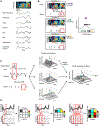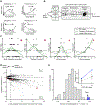Dopamine neurons evaluate natural fluctuations in performance quality
- PMID: 35354031
- PMCID: PMC9013488
- DOI: 10.1016/j.celrep.2022.110574
Dopamine neurons evaluate natural fluctuations in performance quality
Abstract
Many motor skills are learned by comparing ongoing behavior to internal performance benchmarks. Dopamine neurons encode performance error in behavioral paradigms where error is externally induced, but it remains unknown whether dopamine also signals the quality of natural performance fluctuations. Here, we record dopamine neurons in singing birds and examine how spontaneous dopamine spiking activity correlates with natural fluctuations in ongoing song. Antidromically identified basal ganglia-projecting dopamine neurons correlate with recent, and not future, song variations, consistent with a role in evaluation, not production. Furthermore, maximal dopamine spiking occurs at a single vocal target, consistent with either actively maintaining the existing song or shifting the song to a nearby form. These data show that spontaneous dopamine spiking can evaluate natural behavioral fluctuations unperturbed by experimental events such as cues or rewards.
Keywords: CP: Neuroscience; Gaussian process model; basal ganglia; birdsong; dopamine; generalized linear model; motor skill learning; natural behavior; performance prediction error; skill maintenance; ventral tegmental area.
Copyright © 2022 The Authors. Published by Elsevier Inc. All rights reserved.
Conflict of interest statement
Declaration of interests The authors declare no competing interests.
Figures




References
-
- Akaike H (1974). A new look at the statistical model identification. IEEE Trans. Automatic Control 19, 716–723.
Publication types
MeSH terms
Substances
Grants and funding
LinkOut - more resources
Full Text Sources
Miscellaneous

